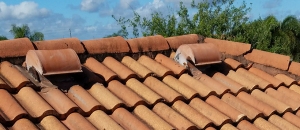The Pros and Cons of Metal Roofs in South Florida
See our list of pros and cons below to determine a metal roof is the right solutions for your home
Choosing a roofing system for your home is a big decision. A metal roof is often seen as superior to shingles due to their quality performance in all types of weather. But is metal the right choice for your home? Let’s take a look at the pros and cons of metal roofing systems.
Metal Roof Pros
Weather Resistant
Palm Beach may be paradise, but Florida summers can really test your home’s roof. Regardless of the material, installation is the key factor in determining how well your roof will hold up to a hurricane or rainy season. A trusted roofing company like Advanced Roofing, Inc. ensures installation adheres to all building codes and a solid deck and foundation is installed.
Metal roofing has an advantage against storms due to its resistance to extremely high winds. According to FloridaDisaster.org, metal roofs in Florida received little to no damage from storms and hurricanes in the last few decades. Damage to metal roofs was usually caused by faulty installation (lack of fasteners, failing of internal pressure from other openers).
Allow for Protective Coatings
A roof coating is a fluid applied to the roofing membrane with elastic properties that allow it to stretch and return to its original shape without damage. Coatings can prolong the life of your roof for up to 10 years. To minimalize damage from constant sun exposure and rainfall, and prolong the life of your roof, a rubber coating is an ideal choice. SEBS Rubber Coating is a synthetic rubber liquid membrane coating specially formulated for use on metal roofs and sidewalls such as entranceways, cement roofs or for aesthetic appearance. It is a low permeable, wash-off resistant product with greater adhesion, resists algae and fungi from forming, and provides a strong bond on roofs subject to ponding water.
Cost Savings
Metal roofs and coating systems are a perfect match because they can save you money on your monthly electricity bill and taxes. Rubber coating systems are Energy Star rated for their high solar reflectance, keeping the air inside your home regulated while protecting your roof from radiating heat. Choose a white coating since they reflect more than 80% of the UV rays. Metal roofs protect against heat and light by reflecting both away from the roofing system, keeping your home cool. To ensure energy efficiency, your roof must be properly vented with quality reflective and radiative products, which also offer “Cool Roof” tax benefits for Florida homeowners.
Insurance Savings
Metal is preferred over traditional systems since its resistant to damages caused by weather and fire, so check with your insurance company to see if they offer savings for using superior materials.
Weight
Metal is a lightweight roofing material which often does not require additional support if your current roofing structure is up to par. Metal roofs also prevent against additional weight over time from absorbed water.
Eco-Friendly
Metal panels can be recycled.
Metal Roof Cons
Cost
The price of a new roof is always a key factor in upgrading your roofing system. A metal roof will cost more than a typical shingle roof (typically double the cost per panel) due to its outperforming qualities mentioned above. Metal roofing is a premium material so you will pay more upfront but will save in the long-term.
Sound
Metal roofs can be loud during storms, especially those with heavy winds or hail. Poor ventilation or loose materials can be a cause for the noise. Applying a layer of insulation over a solid plywood deck should prevent this.
Oil Canning
Oil canning affects all types of metal and looks like waves on the metal’s surface. Although it may be unsightly for some, oil canning does not have an impact on how well your metal roof will perform. It can be caused by installation over an uneven roof decking, improper handling or storage or panels, over-tightening the fasteners, and normal thermal expansion and contraction. To prevent this from happening, choose a panel design with striations as opposed to a flat panel, and select an experienced metal roof installer, like Advanced Roofing.
For a complimentary, no-obligation metal roof estimate, call (561) 571-5556 or click here to submit an online quote request.


